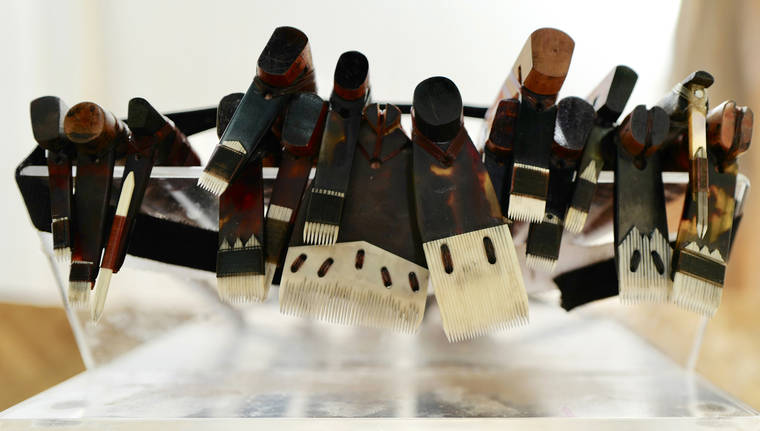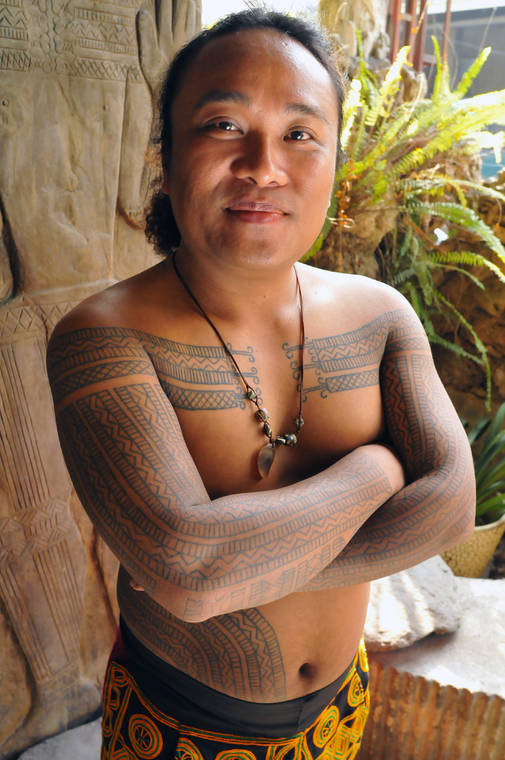NORTH KOHALA — Curiously, there has never been a traditional tattoo festival on the Big Island or even in the state of Hawaii.
That is until now.
Hawaii’s inaugural Traditional Tattoo Festival is slated for Oct. 25-28 in Kohala. The celebration will feature demonstrations by eight master indigenous tattooists and artists from throughout the Pacific, Arctic and First Nation Regions of Canada.
An opening celebration is planned Friday evening, Oct. 25, at the Blue Dragon Tavern &Cosmic Musiquarium in Kawaihae, followed by a free all-day cultural fair Saturday, Oct. 26, in Hawi.
The festivities culminate with a two-day symposium for traditional tattoo artists and practitioners Sunday and Monday, Oct. 27-28, at the Kohala Institute’s GRACE Center in Kapaau.
Given the deep cultural and spiritual significance of traditional tattoo, it seems appropriate that the idea to have a festival came to the organizer, GRACE Center manager Joel Tan, in a dream.
“In my mind, I’ve thought about it as a kind of calling together or gathering of the cousins,” Tan said. “The festival is about bringing together indigenous culture bearers and indigenous artists to share their manao, or knowledge, about current practices that tie us to the past, present and future.”
Traditional tattoo provides an entry point into something much older than us, Tan explained.
“A lot of our kupuna have walked before, so I think reconnecting to that is so important for the future.”
An impressive list of cultural practitioners and master artists have bought in to his vision, agreeing to travel long distances to Hawaii to participate.
“These are people who, as culture bearers, are really leading the way in light of today’s deepening divides, both socially and politically,” Tan said. “They are great artists; people who not only do tattoo but who start education programs for their communities and train other cultural practitioners.
“They have something important to show us around reconnecting to our own native self. It’s a good reminder of what we need right now.”
Featured practitioner Keone Nunes from Oahu is well-known for his work in reintroducing the art of the traditional Hawaiian tattoo, called kakau or tatau.
“Kakau gives mana (spiritual power) to a person,” Nunes said. “The tools (I use) are conduits and the experience is connected to the ancestors. This gathering is an extension of spirit, and all who join in will be able to receive mana and transform.”
The festival is sponsored by the Kohala Institute and supported by grants from the Hawaii Tourism Authority Community Enrichment Program and the Hawaii Council for the Humanities.
“Tattoo is one of those things that can bridge,” Tan said. “For younger people, it’s exciting. It’s a body thing, it’s kinda forbidden and it’s also trendy. My thought was to take that excitement and pair it with the deeper meaning of tattoo.”
And with traditional tattoo, that deeper meaning is far more than skin level.
Traditional tattooing is a long, thought-out and inherently painful process. Using a mallet and tattoo comb dipped in ink, a trained tattoo artist taps designs into the skin following simple marks as a guide. Different types of traditional body marking include hand tapping, hand poking and skin threading.
Meeting with a trained practitioner is a critical first step, Tan explained, as that is when and how you learn about your family lineage, and lineage is one factor that informs what the tattoo will be.
“The tattoo becomes the symbol or the visual communication of what your life mission is and what you are all about,” Tan said. “Just like an organization has a mission statement, your tattoo is your mission statement.
“In the end, it’s coming to that deeper understanding of who you are and your connection to the aina and your ohana that creates the design. The tattoo you end up with is in some ways a byproduct of the process you go through — a painful process both literally and figuratively — to connect more deeply with yourself and your kupuna.”
Considering the nature of the process, actual traditional tattooing will not be available at the festival.
However, people can make a connection with a practitioner to start the process.
“This festival is for folks who are interested in native design and indigenous art and whether or not you actually want a tattoo, you’re going to learn and it’s going to be interesting.”
While the symbols of cultural art differ and vary across cultures, the underlying theme is learning about and making a connection with the patterns that connect us.
“Indigenous art is unique in that it’s an art practice across genres directly tied to spirit,” Tan said. “That’s its power.”
The opening day fair is free, while a one-day pass for Sunday is $30. An all inclusive package with meals and all events is $275 until Oct. 1.
For more information, visit www.traditionaltattoofestivalhi.com or call 889-5151.
Lineup of events
Saturday, Oct. 26: Free local fair for the entire ohana from 9 a.m. to 3 p.m. at the Kohala Village Inn and HUB, 55-514 Hawi Road in Hawi. The event will feature traditional tattoo demonstrations, arts workshops, food trucks and dancing with live music as well as kapa, lauhala weaving and wood-carving demonstrations and a film festival.
Sunday and Monday, Oct. 27-28: The Traditional Tattoo Festival Symposium will be held at the GRACE Center, Kohala Institute, 53-580 Lole Road in Kapaau. Master practitioners will lead live demos and share techniques as well as their manao during talks that will include time for questions and discussion. The symposium will also offer storytelling, fireside awa ritual and locally sourced meals. Cost of the full conference package which includes the opening night ceremony, entry pass for the two-day symposium, seven meals, a tote, temporary tattoos and 10 percent off GRACE Center or HUB Inn accommodations is $275 until Oct. 1; $325 thereafter. A one-day pass for Sunday, 9 a.m. to 4 p.m., is $30.
Film Festival Saturday, Oct. 26: A big part of the Saturday free local fair will be a film festival with award-winning screenings throughout the day.
Master Practitioners and Master Artists at Hawaii’s first Traditional Tattoo Festival:
Lars Krutak, USA: A premiere American anthropologist, photographer and writer, Krutak is known for his research about tattoo and its cultural background. He produced and hosted the 10-part documentary series “Tattoo Hunter” airing on the Discovery Channel. Krutak is continuously studying and researching how tattoos and other forms of body modification “make” the people who wear them. He has acquired many traditional tattoos himself including hand-tapped, hand-poked and hand-pricked designs from Borneo, the Philippines, Indonesia, Thailand and the Brazilian Amazon. He also has approximately 1,000 razor and knife-cut scars across his body from groups in Papua New Guinea, Benin, Ethiopia and Mozambique.
Julia Gray, Inawi Village, Mekeo, Papua New Guinea: Gray has been marking skin since 2013 using traditional hand-poke and hand-tap methods. Inspired by her Bubu or grandmother, she is especially passionate about reinvigorating skin marking for the next generation of Melanesian women. “I am driven to share and inspire pride in our Melanesian ways,” she says. “My Bubu was tattooed. Her gift to me is what I share with you so you may know the story of our women.” Gray was the film maker of the three-part documentary, Tep Tok: Reading Between Our Lines, which will be shown at the festival.
Dion Kaszas, Canada: Kaszas is a tattoo artist, cultural tattoo practitioner, painter, teacher, and scholar of Nlaka’pamux (Interior Salish) heritage. In 2015, with two other artists he started the Earthline Tattoo Collective which aims to enhance, expand and support the work of traditional and cultural indigenous tattoo practices across Canada. Kaszas is featured in Skindigenous, a 13-part documentary series exploring Indigenous tattooing traditions around the world that will be shown at the festival.
Lane Wilcken, Philippines: Recognized by the Filipino-American community as a “mambabatok” or cultural tattoo practitioner, Wilcken uses only ancient hand-tapped tattoo techniques. He makes all his own tools many of which are now extinct in the Philippines. His practice is spiritual and includes meditation and prayer before composing batok (tattoo) arrangement according to the designs and symbols of a person’s ethnic background. Through cultural tattooing he seeks to strengthen cultural pride among Filipinos and to reunite them and Pacific Islanders symbolically and spiritually with their estranged ancestors.
Cudjuy Patridjes, Taiwan: Paiwan artist Cudjuy Patjidres practices traditional tattooing using the ancient method of hand tapping. He began tattooing himself and friends while in high school and his body is wrapped in traditional Paiwan tattoos. While today he tattoos mostly by machine, he is skilled in making traditional Paiwan hand-tapping tools and uses these implements to demonstrate traditional tattoo techniques at cultural events and museums. “I feel a responsibility to bring Paiwan tattoo back since my grandfather was tattooed and he encouraged people to have tattoos,” Patjidres says. “I also have the support of the elders which is very important to me.”
Keone Nunes, Hawaii: Nunes is the go-to artist for people seeking traditional tattoos which will connect them to their Native Hawaiian heritage. He began tattooing using the traditional Polynesian tapping method more than 20 years ago and is one of very few artists left in the world who tattoo in this ancient way. He makes his own tools and ink and says: “I dip the moli (tattoo tool) in the pa’u (ink), place it on the skin and tap, but in its simplicity lies its complexity. It looks fairly simple but is difficult to do well.”
Holly Nordlum, Alaska: Nordlum practices the art of Inuit tattoos called Kakinniit or Tunniit in Inuktitut. She painstakingly hand pokes and hand stitches intricate designs with a needle and cotton thread, which leaves a trail of ink under a person’s skin. It’s an ancient tradition that is seeing a modern revitalization. For nearly 20 years Nordlum has lived in Anchorage, where suicide rates are high and domestic abuse, along with drug and alcohol abuse, are widespread. In revitalizing traditional tattoo she seeks to bring something positive to her people.
Sarah Whalen Lunn, Alaska: Sarah Ayaqi Whalen-Lunn is an Inupiaq multimedia artist specializing in Inuit hand-poked and skin-stitched tattooing, an ancient form of tattooing involving sewing designs directly into the skin or poking the designs on one spot at a time using a needle dipped in dye. Skin stitching was the first form of tattooing the Inuit had and Lunn believes it holds a powerful connection to ancestors when practiced today: “It was said that our markings stay with us as our soul passes to the other side and that our ancestors will recognize us by them.”


